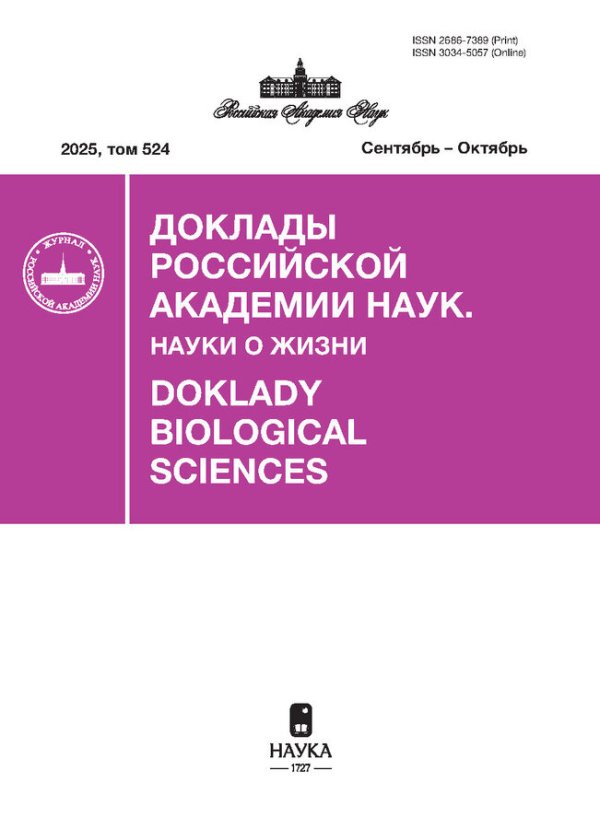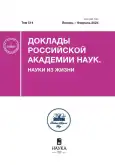Два источника целомической мезодермы у брахиопод
- Авторы: Кузьмина Т.В.1, Темерева Е.Н.1
-
Учреждения:
- Московский государственный университет им. М.В.Ломоносова
- Выпуск: Том 514, № 1 (2024)
- Страницы: 65-68
- Раздел: Статьи
- URL: https://journal-vniispk.ru/2686-7389/article/view/258942
- DOI: https://doi.org/10.31857/S2686738924010124
- EDN: https://elibrary.ru/KPYSYE
- ID: 258942
Цитировать
Полный текст
Аннотация
Формирование целомической мезодермы у Bilateria происходит различными путями и имеет большой интерес с позиций сравнительной эмбриологии и филогении. В данной работе методами сканирующей электронной микроскопии и цитохимии в сочетании с конфокальной лазерной микроскопией показаны ранние стадии онтогенеза брахиоподы Coptothyris grayi. На стадии гаструлы одновременно из передней и задней стенок архентерона формируются два источника мезодермы. И передний, и задний зачатки образуются энтероцельно как непарные выпячивания стенки первичной кишки, которые впоследствии от неё отшнуровываются. Таким образом, были подтверждены ранее известные данные об энтероцельной закладке целома у брахиопод. Кроме того, впервые для всего типа Brachiopoda показано формирование целомической мезодермы из двух зачатков: переднего и заднего. Анализ литературы показывает, что два источника целомической мезодермы характерны для онтогенеза представителей различных групп первичноротых и вторичноротых животных. Этот факт может служить доказательством ранее предложенной гипотезы о плезиоморфии двух источников мезодермы для Bilateria.
Ключевые слова
Полный текст
Брахиоподы – группа морских беспозвоночных, систематическое положение которой долгое время оставалось спорным. В настоящее время брахиоподы вместе с форонидами и мшанками входят в состав таксона Spiralia [1], для большинства представителей которых описан схизоцельный способ формирования целома. Тем не менее, в 19 и 20 веках для брахиопод был обнаружен энтероцельный способ закладки целома, сходный с вторичноротыми животными [2, 3, 4, 5]. Однако современное исследование [6] показало, что у брахиопод при формировании целома не происходит выпячивания эпителия архенерона, а происходит выселение плотной массы мезодремальных клеток, которые путем расхождения формируют целомические полости, таким образом, напоминающий схизоцельный способ закладки целома.
Цель настоящей работы – изучить формирование мезодермы брахиопод на примере Coptothyris grayi.
Материалом для работы послужили взрослые особи брахиоподы Coptothyris grayi (Davidson, 1852), собранные в заливе Восток Японского моря в районе морской биологической станции “Восток” Национального научного центра морской биологии им. А. В. Жирмунского ДВО РАН. Последовательные стадии развития были получены путем искусственного оплодотворения [7], расслаблены в 3.5 % растворе MgCl2 и зафиксированы в 4 % параформальдегиде на 0.1М фосфатном буфере. Тонкая морфология последовательных стадий развития была изучена методом сканирующей электронной микроскопии (СЭМ), для чего фиксированный материал был обезвожен в спиртах восходящей концентрации и ацетоне, высушен в критической точке на аппарате сушки Hitachi critical point dryer HCP-1, смонтирован на столики и напылен тяжелыми металлами. Препараты изучали в сканирующем электронном микроскопе JEOL JSM-6380LA в межкафедральной лаборатории электронной микроскопии Биологического факультета МГУ. Для изучения на конфокальном лазерном сканирующем микроскопе (КЛСМ) зафиксированный материал отмывали в фосфатном буфере с 5 % Triton-X100, в течении 24 часов и затем инкубировали в растворе фаллоидина Phalloidin-FITC-495 Sigma P5282 (1:100) и DAPI Sigma D9542 (1:1000) в течение 2 часов при комнатной температуре. Материал был изучен в лазерном конфокальном микроскопе Nikon Eclipse Ti (Tokyo, Japaт). Z-проекции были сделаны в программе ImageJ 1.43; 3D реконструкции построены в программе Amira ver. 5.2.2.
Для Coptothyris grayi характерно наружное оплодотворение, выход из яйцевых оболочек происходит на стадии поздней бластулы. В воде происходит гаструляция путем инвагинации: формируется архентерон, который связан с внешней средой через округлый бластопор. Через 15 часов после оплодотворения (чпо) бластопор на вегетативном полюсе гаструлы удлиняется, таким образом формируется билатерально симметричная поздняя гаструла, плоскость симметрии которой совпадает с плоскостью вытянутого бластопора (рис. 1, а). На этой стадии передний и задний участки эпителия архентерона формируют выпячивания, образуя передний и задний целомические мешки (рис. 1, б–в). Таким образом, энтероцельным путем формируется и передняя, и задняя мезодерма. Передний и задний целомический мешок имеют по паре латеральных выростов, которые располагаются по бокам от архентерона (рис. 1, б–в). Через 22 чпо формируется ранняя трехлопастная личинка, которая состоит из хорошо развитых головной и ножной лопастей, между которыми располагается кольцевидное утолщение – зачаток мантийной лопасти (рис. 1, г).
Рис. 1. Формирование мезодермы у личинки брахиоподы Coptothyris grayi: (а) – поздняя билатерально симметричная гаструла (15 чпо), СЭМ, (б) – формирование передней мезодермы на стадии поздней гаструлы, частичная Z-проекция части после окраски DAPI, КЛСМ, (в) – формирование задней мезодермы на стадии поздней гаструлы, частичная Z-проекция после окраски DAPI, КЛСМ, (г) – ранняя трехлопастная личинка (22 чпо), СЭМ, (д) – Z-проекция ранней трехлопастной личинки после окраски DAPI, КЛСМ, (е) – Z-проекция ранней трехлопастной личинки после окраски фаллоидином, КЛСМ. (al) – головная лопасть, (am) – передняя мезодерма, (ar) – архентерон, (bl) – бластопор, (pl) – ножная лопасть, (pm) – задняя мезодерма, (rml) – зачаток мантийной лопасти, стрелки указывают на переднюю мезодерму, наконечники стрелок указывают на заднюю мезодерму.
На этой стадии передний целомический мешок оказывается расположенным в головной лопасти личинки, а целомический мешок задней мезодермы подразделяется на две пары мешков, которые располагаются по бокам от архентерона в зачатке мантийной и ножной лопастях. После этого целомические мешки начинают сливаться между собой, формируя общий целомический зачаток, частично подразделенный на три пары целомических полостей (рис. 1, д–е). Одновременно происходит замыкание бластопора от заднего конца к переднему.
Таким образом, полученные результаты подтверждают данные Ковалевского, Конклина и Персиваля [2, 3, 4, 5] о настоящей энтероцелии у брахиопод. Важно отметить, что личинки современных ринхонеллиформных брахиопод лецитотрофные. При этом все клетки личинки очень крупные и заполнены желточными гранулами, а между базальными пластинками эктодермы и энтодермы очень мало места. Поэтому внутри личинок брахиопод нет обширных целомических полостей, а зачатки целомических полостей представляют собой группу близко расположенных клеток, несущих апикальные реснички. Эти клетки связаны адгезивными контактами и окружены базальной пластинкой. Вероятно, Карстен Лютер [6] зачатки уже сформированных целомических полостей рассматривал как плотную массу мезодермальных клеток. Можно предположить, что схизоцельный способ закладки целома произошел от энтероцельного из-за малоклеточности эмбриона и нехватки места между энтодермой и эктодермой. При этом у брахиопод наблюдается переходная стадия, когда целомические полости закладываются в виде карманов архентерона, но при этом настоящая целомическая полость появляется позже путем расхождения плотно сближенных клеток.
В данной работе впервые для брахиопод описано формирование передней и задней мезодермы. Формирование двух источников мезодермы описано также для разных других групп билатерально симметричных животных, таких как Spiralia [8, 9 10], Ecdysozoa [11, 12] и Deuterostomia [13, 14]. Кроме того, наличие передней и заднего и переднего мезодермальных зачатков также обнаружено у других представителей лофофорат, например, у форонид [15, 16]. Вероятно, наличие двух источников мезодермы является плезиоморфным признаком для всех Bilateria [15]. Недавно было предположено, что наличие двух источников мезодермы подтверждает гипотезу амфистомии, в которой формирование рта и ануса Bilateria произошло путем слияния боковых сторон вытянутого щелевидного рта книдариоподобных предков. Передний и задний источники мезодермы связаны с передним и задним концами кишечной трубки и, вероятно, произошли от круговой области формирования мезодермы радиально симметричного предка Bilateria [10, 15]. Наличие у брахиопод энтероцельного способа закладки целома позволяет предположить, что эта группа животных сохранила плезиоморфные черты, вероятно, свойственные общему предку Bilateria.
ИСТОЧНИК ФИНАНСИРОВАНИЯ
Работа выполнена при финансовой поддержке гранта РНФ (№ 23-14-00020).
КОНФЛИКТ ИНТЕРЕСОВ
Конфликт интересов отсутствует.
Об авторах
Т. В. Кузьмина
Московский государственный университет им. М.В.Ломоносова
Email: temereva@mail.ru
Россия, Москва
Е. Н. Темерева
Московский государственный университет им. М.В.Ломоносова
Автор, ответственный за переписку.
Email: temereva@mail.ru
Россия, Москва
Список литературы
- Halanych K. M., Bacheller J. D., Aguinaldo A. M., et al. Evidence from 18S ribosomal DNA that the lophophorates are protostome animals // Science. 1995. V. 267. P. 1641–1643.
- Kovalevsky A. O. Observations sur le developpement des brachiopods (Analysis by Oehlert and Deniker) // Arch. Zool. Exp. Gen. Sér. 1883. V. 2. P. 57–76.
- Conklin E. G. The embryology of a brachiopod, Terebratulina septentrionalis Couthouy // Proc. Am. Philos. Soc. 1902. V. 41. P. 41–76.
- Percival E. A contribution to the life-history of the brachiopod Terebratella inconspicua Sowerby // Trans. R. Soc. New Zealand. 1944. V. 74. P. 1–23.
- Percival E. A contribution to the life-history of the brachiopod Tegulorhynchia nigricans // Quat. J. microsc. Sci. 1960. V. 101. P. 439–457.
- Lüter C. The origin of the coelom in Brachiopoda and its phylogenetic significance // Zoomorphology. 2000. V. 120. P. 15–28.
- Kuzmina T. V., Malakhov V. V., Temereva E. N. Larval development of the brachiopod Coptothyris grayi (Davidson, 1852) (Terebratulida: Rhynchonelliformea) and the evolution of brachiopod life cycles // Invert. Zool. 2019. V. 16. № 1. P. 27–40.
- Boyer B. C., Henry J. J., Martindale M. Q. The cell lineage of a polyclad turbellarian embryo reveals close similarity to coelomic spiralians // Dev. Biol. 1998. V. 204. P. 111–123.
- Henry J. Q., Martindale M. Q. Conservation of the spiralian development program: Cell lineage of the nemertean Cerebratulus lacteus // Dev. Biol. 1998. V. 201. P. 253–269.
- Lartillot N., Le Gour M., Adoutte A. Expression patterns of fork head and goosecoid homologues in the mollusk Patella vulgate supports the ancestry of the anterior mesentoderm across Bilateria // Dev. Gen. Evol. 2002. V. 212. P. 551–561.
- Weygoldt P. Embryologische Untersuchungen an Ostracoden: Die Entwicklung von Cyprideis litoralis // Ibid. 1960. V. 78. P. 370–426.
- Benesch R. Zur Ontogenie und Morphologie von Artemia salina // Zool. Jahrb. Anat. 1969. V. 86. P. 307–458.
- Seifert R., Jacob M., Jacob H. J. The avian prechordal head region: a morphological study // J. Anat. 1993. V. 183. P. 75–89.
- Kiecker C., Niehrs C. The role of prechordal mesoderm in neural patterning // Curr. Opin. Neurobiol. 2001. V. 11. P. 27–33.
- Temereva E. N., Malakhov V. V. Embryogenesis and larval development of Phoronopsis harmeri Pixell, 1912 (Phoronida): dual origin of the coelomic mesoderm // Invertbr. Reprod. Dev. 2007. V. 50. № 2. P. 57–66.
- Temereva E. N., Malakhov V. V. Embryogenesis in phoronids // Invert. Zool. 2012. V. 9. № 1. P. 1–39.
Дополнительные файлы











